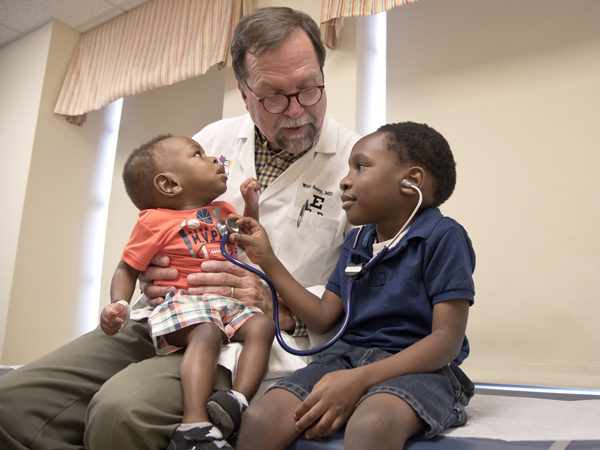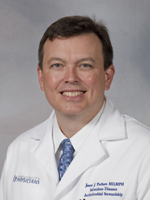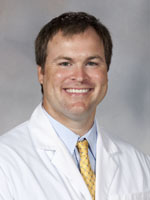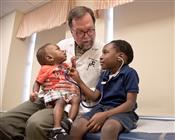Just when is it time for an antibiotic?

Published in News Stories on October 08, 2015
In his work in the Division of Infectious Diseases at the University of Mississippi Medical Center, Dr. Jason Parham sees how aggressive antibiotic treatment can swiftly save a dangerously ill patient.
Unfortunately, he also sometimes sees the opposite scenario: patients with serious infections who don't get better because the infection is caused by multi-drug resistant bacteria and no longer responds to antibiotics.
In some instances, it's because the patient has been exposed to too many antibiotics in the past. Perhaps it's because a physician prescribed a longer antibiotic regimen than necessary, or a more broad-spectrum antibiotic than the infection needed. Maybe it occurred after the patient was prescribed antibiotics inappropriately for a virus, or an infection that would have gone away without treatment.

Parham
Antibiotic resistance can occur with exposure to antibiotics given for any reason, which makes it all the more tragic when the use was unnecessary.
“We're the gatekeepers,” Parham, an assistant professor, said of physicians and advance practice providers. “We're ultimately responsible for antibiotic misuse.”
Parham is part of the solution. As leader of UMMC's antimicrobial stewardship program, he is talking to physicians and other providers about the best use of antibiotics and the possible repercussions to the patient and the community when they're not appropriately given.

In September, the Joint Commission introduced a program called “Speak Up” that educates the public about the appropriate and safe use of antibiotics and details risks associated with taking too many over time. The Commission says that each year, an estimated 2 million people in the United States become infected with bacteria that don't respond to antibiotics, and that antibiotics can also kill good bacteria in addition to bad. That's led to antibiotic overuse becoming a critical health and patient safety issue.
“Studies over the years suggest that antibiotics are overprescribed 30 to 50 percent of the time,” Parham said. Worries about misuse of antibiotics aren't new, he said. Within a few years of the widespread production of penicillin for patient use, its discoverer, Alexander Fleming, “was cautioning providers to avoid giving the antibiotic for conditions where it was not needed.”
But thanks to initiatives like Speak Up, “there's been a more concerted effort by the Centers for Disease Control and Prevention, the Infectious Diseases Society of America and the Society for Healthcare Epidemiology of American to increase awareness and take the campaign not only to physicians, but to families,” he said. “There's got to be a culture shift, both in providers and patients, but I do believe that it's possible with the help of antimicrobial stewardship programs.”
UMMC's stewardship program uses computer software to identify inpatients that could benefit from optimization of antimicrobials. Infectious diseases-trained healthcare providers don't interact with patients face to face, but instead review each patient's chart to determine if recommending a change in antimicrobials is advisable.
The program contacts the provider to discuss recommendations. That could include exploring whether a doctor should administer a different antibiotic, a different dose or route of administration, a different duration, or even additional clinical work-up, including lab cultures or imaging, “to make sure we are doing the best we can to optimally treat infections with the best regimen possible,” Parham said. “The goal is to obtain the best outcomes for our patients by following evidence-based care.”
Providers follow stewardship recommendations about 85 percent of the time, Parham said.
“We review about 5,000 charts a year and do 50 to 100 interventions per month,” Parham said. “We collaborate with the clinical microbiology lab, the departments of pathology and pharmacy, and hospital epidemiology in order to understand how published studies and guidelines should be applied to deliver the best care possible at UMMC. We exist to help prescribers make appropriate treatment decisions for their patients, and hopefully to prolong the efficacy of our antimicrobials for future patients.”

Garriga
Dr. Brandon Garriga, a UMMC School of Medicine graduate and fellow in pulmonary and critical care medicine, said the stewardship program is helping him make the best decisions for his patients.
“In the ICU and critical care world, we use fairly aggressive antibiotics,” Garriga said. “The (stewardship program) is following us from afar, and will make suggestions on de-escalating antibiotics within 72 hours of treating a patient. It's good to have someone looking and making suggestions on de-escalating.”
There can be an expectation that when patients pay for a doctor's services, “they're not necessarily satisfied with the visit until the physician prescribes them an antibiotic,” Parham said.
That's especially true of some moms who bring their kids to see UMMC pediatrician Dr. Will Sorey. “I've had them tell me, 'I just can't stand not to do anything,' when their child has a virus. People want to do something,” said Sorey, a professor of pediatrics. “I tell them that viral illnesses are not treatable. I wish they were. But by the time you are sick with it, the virus has done its dirty work and is on the road.”
Jackson mom Dominique Lenard said she understood why doctors at Children's of Mississippil's Eli Manning Clinic didn't prescribe an antibiotic when her 5-year-old, Ca'Marii Washington, had the flu. As a nursing assistant, Lenard said, she knows that antibiotics can be overused.
But she's glad Ca'Marii in the past was prescribed antibiotics for multiple ear infections and for strep throat, Lenard said. Her 11-month-old Drue hasn't had any infections. Unless they're truly necessary, “we try not to take them,” Lenard said of antibiotics.
As the public becomes more aware of the potential for antibiotic misuse, Parham said, “increasingly, we're seeing patients who ask, 'Is an antibiotic really necessary?'
“As physicians, we must spend the time required to explain to patients why they don't need an antibiotic, and then give them a plan of action to treat their symptoms and to know what they should do if they aren't getting better.”
Said Sorey: “Don't yank antibiotics away from the people who need them, but don't throw a handful of medicine to people who don't need it. The average American, frankly, doesn't have an appreciation for how serious this is.”
The UMMC stewardship program is bearing fruit. “We've been able to show improvements in the use rate of targeted antimicrobials in the range of 15 to 40 percent,” Parham said. “A review of the UMMC antibiogram shows that some of the bacteria in clinical cultures here are becoming more susceptible to antibiotics, and that's at least partially due to our improved use of antibiotics.”
Medical Center physicians continue to tackle the worst of the worst infections. “Probably the most common from the community are MRSA (methicillin-resistant Staphylococcus aureus) infections,” Parham said. Of most concern, he said, are gram-negative bacteria that are multi-drug resistant, and that produce enzymes that deactivate many of the best antibiotics.
“They can produce bloodstream infections, including sepsis, as well as wound infections, urinary tract infections or pneumonia. We do have antibiotics that can treat them, but they may not be as effective, or may have more side effects. That limits our options,” Parham said.
Bacteria antibiotic resistance “is one of the main problems we deal with in the hospital,” Garriga said. “We need to use the most appropriate and most narrow spectrum of antibiotics that we can to lessen the chance of further antibiotic resistance. This should be one of our goals throughout the hospital.”
Parham believes both patients and doctors are beginning to get the message on antibiotic overuse. “We want patients to not be afraid of taking antibiotics if their doctor feels like they are necessary, but they need to be empowered to get their physician to explain why they need to be on an antibiotic.”
“It's going to take patients, the pharmaceutical industry and the medical establishment to all pull together and use common sense,” Sorey said. “We can step up to the plate and treat it correctly. If your doctor says it's a virus, take them at their word.”
Photos
 | High Resolution Medium Resolution Low Resolution |


